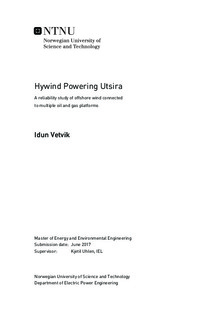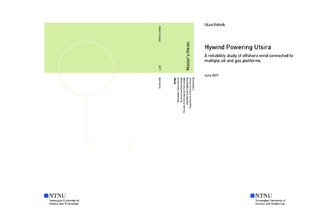| dc.description.abstract | Today four oil and gas platforms are being commissioned in the Utsira High area. One of the platforms is powered from shore by a 120MW/+-80 kV HVDC cable. The three other platforms will first be powered by gas turbines placed on the platforms before a second HVDC-cable rated at 200 MW are connected. After the second cable is connected, the platforms will be interconnected with AC subsea cables in a radial network and all the platforms will be powered from shore. After the area is fully electrified, the gas turbines will work as backup generation. Connecting floating wind turbines to the platforms could be a way of decreasing the emissions from the gas turbines, decrease the power imported from shore, while at the same time improve the reliability of the system.
The aim of this master thesis is to investigate the possible benefits of including an additional connection between the platforms at the Utsira Hight Area and connecting a floating wind farm. Wind speed fluctuations and unpredictable power production can affect the reliability and operation of power systems. The impact of integrating offshore wind to the power system at Utsira High needs to be carefully investigated. Different ways of incorporating wind power in reliability evaluations will be investigated and compared.
In this thesis, two different connecting schemes and two different generation options have been studied, creating four different cases for the composite generation and transmission reliability study.
Base Case: Radial grid, no connected wind power
Case 1: Radial grid, 60 MW connected wind power
Case 2: Ring grid, no connected wind power
Case 3: Ring grid, 60 MW connected wind power
All the different cases are assumed to have both HVDC connections to shore connected and to have the gas turbines installed. In addition, several analyses have been made on variations of these cases. Among these variations were varying reliability parameters and different load values.
For the generation adequacy analysis, only the generation system is studied, and the transmission system is neglected. The simplified system mod-els in the generation system adequacy consist of the installed generating units (3 gas turbine generators and two HVDC-connections to shore) and the total system load. Hence the different composite cases, the Base Case, Case 1, 2, and 3 is not studied in the generation adequacy analysis. In this thesis, the generation system adequacy is studied with and without 60 MW wind power, with different system load values and different reliability parameters for the wind turbines, and the wind farm is in addition modelled using different methodologies.
For the generation reliability analyses, a tool was developed in MatLab to analytically calculate the reliability indices for different input. Wind was modelled using different methodologies, incorporating mechanical unavailability of each wind turbine as well as unavailability due to the wind speed. Varying reliability parameters were used and compared to see the impact of the mechanical availability of wind turbines. For the composite generation and transmission system reliability analyses, Matlab and Microsoft Excel was used to build a mathematical model of the system and calculate the reliability indices using an analytical method.
By performing reliability analyses and considering the actual production from the generating units and the different power demands, the amount of energy that is not served has been calculated for the different cases and for the generation systems. The total costs of the energy not served in the different connection schemes have been studied by using KILE-costs to estimate production loss.
Comparing the different cases in the composite analysis, it was clear that adding wind power or adding more generation to the system had a larger impact on the reliability compared to the impact from creating a ring grid. The results yielded by the analyses show that Case 3 is the best option among the four when focusing on improved reliability. However, the improvement from adding both wind power and the extra cable proved to be less than the improvement of adding just one of the options individually. From generation system analysis, it was clear that the choice of wind model methodology had a larger impact on the reliability com-pared to the forced outage rate of the wind turbines. | |

